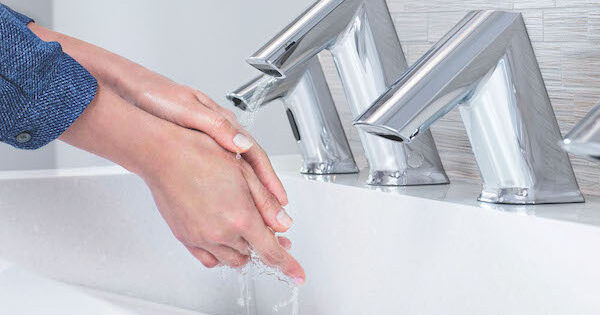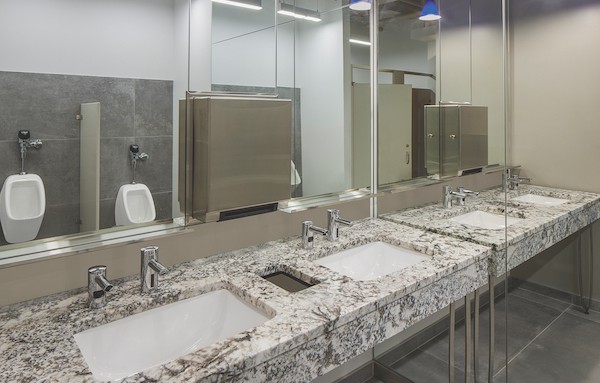By Morgan Kish
From the February 2024 Issue
As 2024 begins, it’s hard to believe its been nearly four years since the onset of the COVID-19 lockdowns.
Employees were forced to work from home, and office buildings were left empty. Workplaces all over the world had to make drastic changes overnight.
Now, over the past four years, we’ve seen the shift back to normal, and employees have been gradually returning to the office. According to data from Kastle Systems, during the first week of September 2023, the average office occupancy rate in the top 10 cities in the U.S. was 47.3% of pre-pandemic levels, compared to 44% the year prior.
That number is only expected to rise. In fact, according to an August report from Resume Builder, 90% of companies plan to implement return-to-office policies by the end of 2024.

And as employees return to the office, they want to know that they’re re-entering a space that’s safe and hygiene friendly. As the second-most visited space in any commercial building, the restroom is at the center of this focus.
That’s why it’s important to have touch-free fixtures that create an entirely hands-free restroom experience to give employees peace of mind. From hygienic benefits for the end user, as well as easing the burden on facility managers, commercial restroom innovation can go a long way toward helping employees and maintenance staff as their time spent in the office increases.
Touch-Free Restroom Trends
Demand for touch-free restroom products rose significantly in 2020—and for good reason, as restroom surfaces can be a breeding ground for the COVID-19 virus and other germs. In fact, there can be 500,000 microbes of bacteria per square foot in a restroom just one hour after cleaning.
That’s why commercial restrooms are now being redesigned to create an entirely touch-free experience from the moment guests enter the restroom. This starts with the entryway, where entrances and exits are being designed without doors, or with sensor-operated doors.
Commercial restrooms are now being redesigned to create an entirely touch-free experience from the moment guests enter the restroom.
Touch-free fixtures—ranging from faucets, soap dispensers, hand dryers, flushometers, and more—are nothing new at this point. But new fixture designs continue to raise the bar on how this innovation can be utilized throughout the restroom to help guests practice proper hand hygiene.
Take guided handwashing faucets, for example. These touch-free, intelligent faucets are helping guests through a self-guided and Centers for Disease Control and Prevention (CDC)-compliant handwash to improve hand hygiene. An LCD display walks guests through a five-step process—wet, lather, scrub, rinse, and dry—to ensure best handwashing practices.

Commercial venues of all types are following suit to provide guests with a hygiene-friendly restroom experience. Fulton East, a new commercial office and retail building located in Chicago’s Fulton Market District, is the nation’s first next-generation office building designed to specifically address employee health, safety, and wellness in a post-COVID-19 environment. And the restroom is a big part of that, as the building’s restrooms present tenants with a totally hands-free handwashing experience to eliminate the cross-contamination concerns that come along with manual fixtures.
Maintenance Matters
Touch-free technology is a consumer benefit first and foremost, but it has proven to be beneficial to maintenance teams as well.
Integrated sink systems—where a sink, faucet, soap dispenser, and hand dryer all work together as one touch-free system—are growing increasingly popular. Each element works together within arms-length to promote hygiene, but they also help to prevent slip and fall hazards.
Are These The World’s Coolest Hand Dryers?
In a partnership with Excel Dryer, Artists For Humanity installed customized hand dryers featuring artwork by local teens in its Boston facility’s bathrooms. Read more…
Guests no longer need to move from the sink over to paper towel dispensers and hand dryers to dry their hands, potentially dripping water on the floor in the process. This also eliminates the need for paper towels to overflow in the trash can or being flushed down the toilet, requiring extra maintenance work.
The Internet of Things (IoT) has also become an additional benefit when it comes to hands-free innovation. Connected products are now making facility maintenance easier than ever, enabling facility managers to proactively monitor their fixtures without ever having to step foot in the restroom. Facility managers now have the ability to quickly change settings and run diagnostics, proactively troubleshoot issues, and monitor usage to perform preventative maintenance before an issue arises—all from a smartphone.
Not only does this help make restroom maintenance less of a burden on facility maintenance teams, but it also gives more time back in their day to tend to other areas of the building.
 Kish is Sloan’s Senior Product Line Manager for Sinks, Faucets, Soap Dispensers, and Shower heads. Sloan has been providing innovation in water-saving fixtures for 118 years.
Kish is Sloan’s Senior Product Line Manager for Sinks, Faucets, Soap Dispensers, and Shower heads. Sloan has been providing innovation in water-saving fixtures for 118 years.
Do you have a comment? Share your thoughts in the Comments section below, or send an e-mail to the Editor at jen@groupc.com.

















 Are These The World’s Coolest Hand Dryers?
Are These The World’s Coolest Hand Dryers?

![[VIDEO] Collect Asset Data at the Speed of Walking a Building](https://facilityexecutive.com/wp-content/uploads/2024/02/maxresdefault-324x160.jpg)